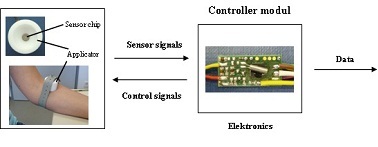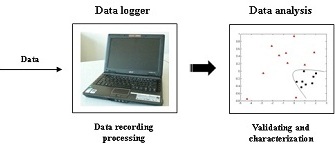Electronic nose could detect heart failure
5 September 2011
A team at University Hospital Jena in Germany is developing a non-invasive method using gas sensors to detect volatile compounds given off by people suffering from heart failure. The project was presented at the ESC Congress 2011 last week.
The 'electronic nose' system consists of an array of three thick-film metal-oxide-based gas sensors with heater elements. Each of the sensors has a slightly different sensitivity to various odorant molecular types.
Interactions between molecules and the sensor are caused by reactions with oxygen on the heated sensor surface leading to a change of the free charge carrier concentrations and thus to a change in conductivity in the metal oxide layer. The odour components are divided by a statistical analysis into two principal components. Further work is in progress to identify the responsible components.


How the electronic nose works
Two groups were formed with CHF patients: one with decompensated heart failure and one with compensated heart failure. The patients with decompensated heart failure could be divided from compensated heart failure with 89% sensitivity and 88% specificity. Cardiovascular drug use was not different in these groups. On the other hand, patients without heart failure (control group) were different from the patients with heart failure in the principal-component analysis (89% sensitivity and 84% specificity).
“The early detection of chronic heart failure (CHF) through periodic screening facilitates early treatment application” said investigator Vasileios Kechagias from the University Hospital Jena.
Heart failure is a common, costly, disabling and potentially deadly condition. In developed countries, around 2% of adults suffer from heart failure, but in those over the age of 65, this increases to 6–10%. Mostly due to costs of hospitalisation, it is associated with high health expenditure. Heart failure is associated with significantly reduced physical and mental health, resulting in a markedly decreased quality of life. Although some people survive many years, progressive disease is associated with an overall increased mortality and morbidity. The aim of the project is to create and establish a minimal invasive method, which will help to rapidly screen, diagnose, group and monitor the CHF.